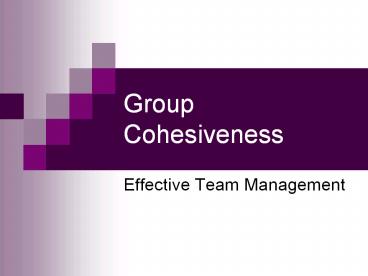Group Cohesiveness - PowerPoint PPT Presentation
Title:
Group Cohesiveness
Description:
Group Cohesiveness Effective Team Management Group Cohesiveness The degree to which members are attracted to or loyal to their group or team. High Group Cohesiveness ... – PowerPoint PPT presentation
Number of Views:3538
Avg rating:3.0/5.0
Title: Group Cohesiveness
1
Group Cohesiveness
- Effective Team Management
2
Group Cohesiveness
- The degree to which members are attracted to or
loyal to their group or team. - High Group Cohesiveness
- Individuals strongly value their group
membership, find the group appealing and have
strong desires to remain part of the group. - Low Group Cohesiveness
- Group members do not find their group
particularly appealing and have little desire to
retain their group membership.
3
Sources and Consequences of Group Cohesiveness
4
Factors Leading to Group Cohesiveness
- Four factors contribute to the level of group
cohesiveness - Group Size
- Effectively Managed Diversity
- Group Identity and Healthy Competition
- Success
- These factors are known as determinants of group
cohesiveness.
5
Group Size
- Members of small groups tend to be more motivated
and committed than members of large groups. - Managers should form groups that are small to
medium in size to promote cohesiveness. - 2 to 15 members per group.
6
Effectively Managed Diversity
- People tend to like and get along with others who
are similar to themselves. - Maintaining diversity in groups can help an
organization gain a competitive advantage. - Managers need to make sure the diversity in
knowledge, experience and expertise necessary for
group goal accomplishment is represented in
groups and that the groups are effectively
managed so that groups will be cohesive.
7
Group Identity and Healthy Competition
- Managers can encourage groups to develop their
own identities or personalities and engage in
healthy competition to increase group
cohesiveness. - Managers can decrease cohesiveness by promoting
organizational identity and making the
organization as a whole the focus of the groups
efforts.
8
Success
- As groups become more successful, they become
increasingly attractive to their members and
their cohesiveness tends to increase. - Managers can increase cohesiveness by making sure
a group can achieve some noticeable and visible
successes.
9
Consequences of Group Cohesiveness
- Three major consequences of group cohesiveness
- Level of participation within the group
- Level of conformity to group norms
- Emphasis on group goal accomplishment
10
Level of Participation Within a Group
- As group cohesiveness increases, the extent of
group members participation within the group
increases. - Participation contributes to group effectiveness
because group member are actively involved in the
group, ensure that the group tasks get
accomplished, readily share information with each
other and have frequent and open communication.
11
Level of Conformity to Group Norms
- Low cohesiveness can result in too much deviance
and undermine the ability of a group to control
its members behaviors. - Increasing levels of group cohesiveness result in
increasing levels of conformity to group norms.
12
Emphasis on Group Goal Accomplishment
- As group cohesiveness increases, the emphasis
placed on group goal accomplishment also
increases within a group. - A moderate level of cohesiveness motivates group
members to accomplish both group and
organizational goals. - High levels of cohesiveness can cause group
members to be so focused on group goal
accomplishment that they may strive to achieve
group goals no matter what.

